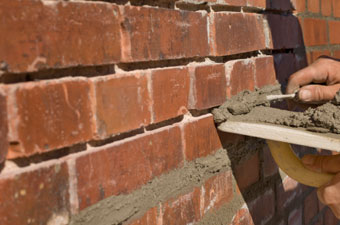Tuck-Pointing
 Tuck-pointing is the process of infilling mortar joints that have damage or deterioration. Mortar is reapplied inside mortar joints and finished to a desired specification with hand tools by a qualified mechanic. Mortar is a combination of portland, lime, sand and water and has been used in construction for thousands of years. Over time, the mortar between brick or stone is exposed to weather changes and UV light. Bricks have a hard-baked clay outer surface and stone is incredibly durable, therefore, the weakness in masonry lies in the mortar joints. The mortar joints weaken over time, settlement cracks form and allow for water to penetrate the inside of the masonry wall. Once water penetrates inside the masonry wall, the damage will then escalate quickly. To avoid masonry wall section restoration or rebuilding, tuck pointing is required to prevent further mortar joint damage. Mortar joint grinding is usually done before tuck-pointing to allow for new mortar to adhere inside the mortar joint. Hand held grinders with diamond-tip blades, machining mortar joints to a depth of approximately 5/8”. Although grinding mortar joints is not always necessary, when done, it ensures the most effective and long term value of your tuck-pointing project. Tuck-pointing applications are usually recommended on older residential and commercial buildings. Property that is in access of 50 years should be inspected for damage to avoid costly repairs. Tuck-pointing offers a great value in both prolonging structural integrity of building and adding beauty at the same time.
Tuck-pointing is the process of infilling mortar joints that have damage or deterioration. Mortar is reapplied inside mortar joints and finished to a desired specification with hand tools by a qualified mechanic. Mortar is a combination of portland, lime, sand and water and has been used in construction for thousands of years. Over time, the mortar between brick or stone is exposed to weather changes and UV light. Bricks have a hard-baked clay outer surface and stone is incredibly durable, therefore, the weakness in masonry lies in the mortar joints. The mortar joints weaken over time, settlement cracks form and allow for water to penetrate the inside of the masonry wall. Once water penetrates inside the masonry wall, the damage will then escalate quickly. To avoid masonry wall section restoration or rebuilding, tuck pointing is required to prevent further mortar joint damage. Mortar joint grinding is usually done before tuck-pointing to allow for new mortar to adhere inside the mortar joint. Hand held grinders with diamond-tip blades, machining mortar joints to a depth of approximately 5/8”. Although grinding mortar joints is not always necessary, when done, it ensures the most effective and long term value of your tuck-pointing project. Tuck-pointing applications are usually recommended on older residential and commercial buildings. Property that is in access of 50 years should be inspected for damage to avoid costly repairs. Tuck-pointing offers a great value in both prolonging structural integrity of building and adding beauty at the same time.
Tuck Pointed Walls
- Masonry Tuckpointing



